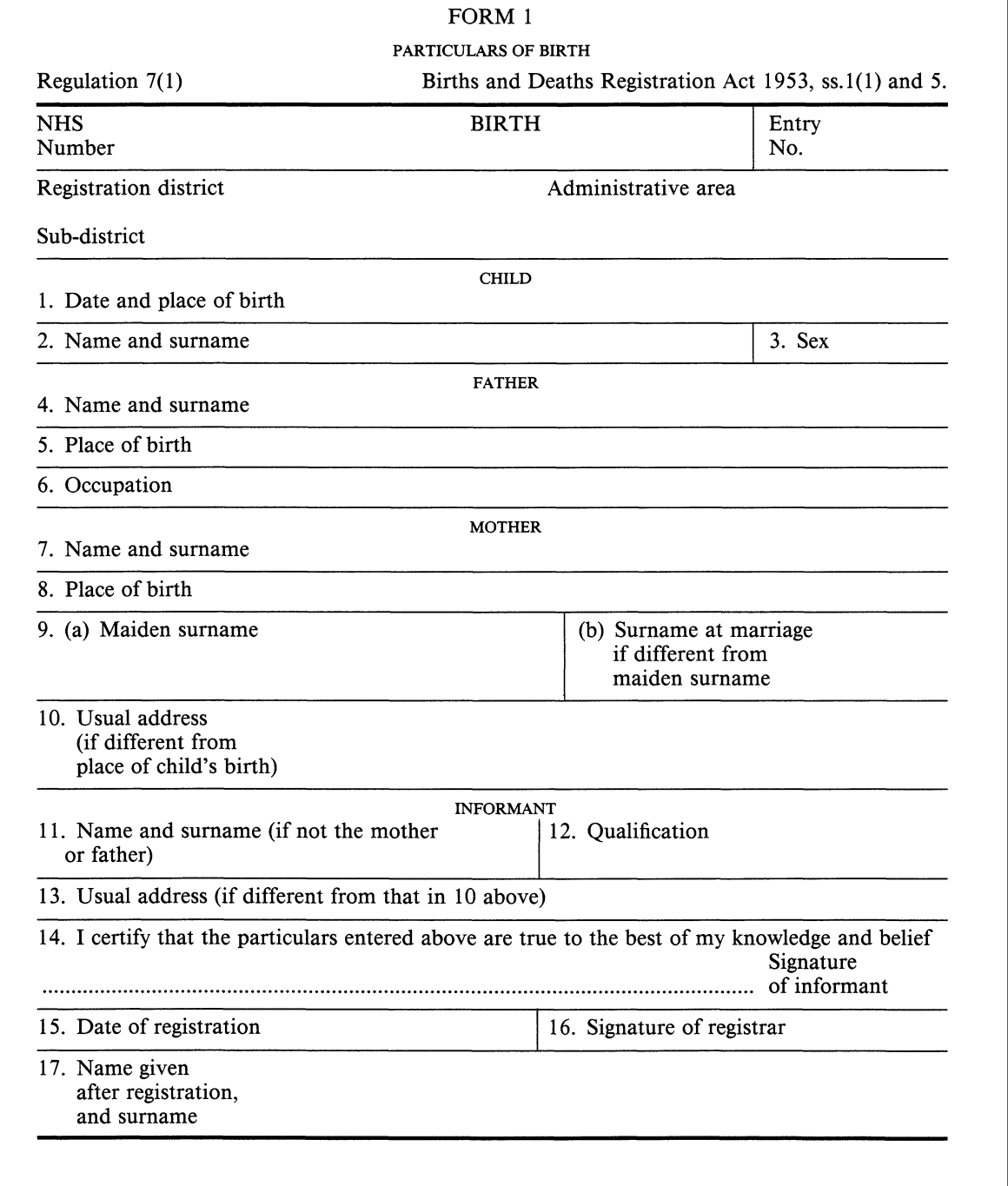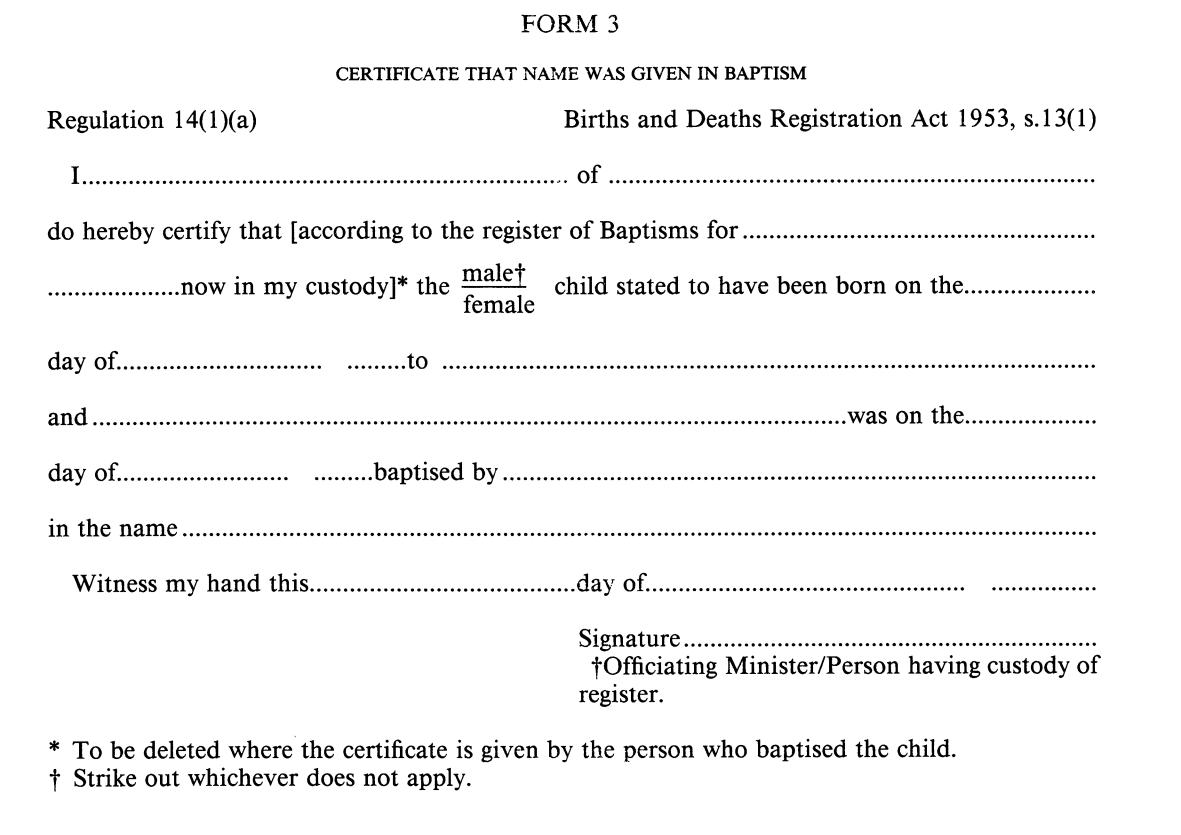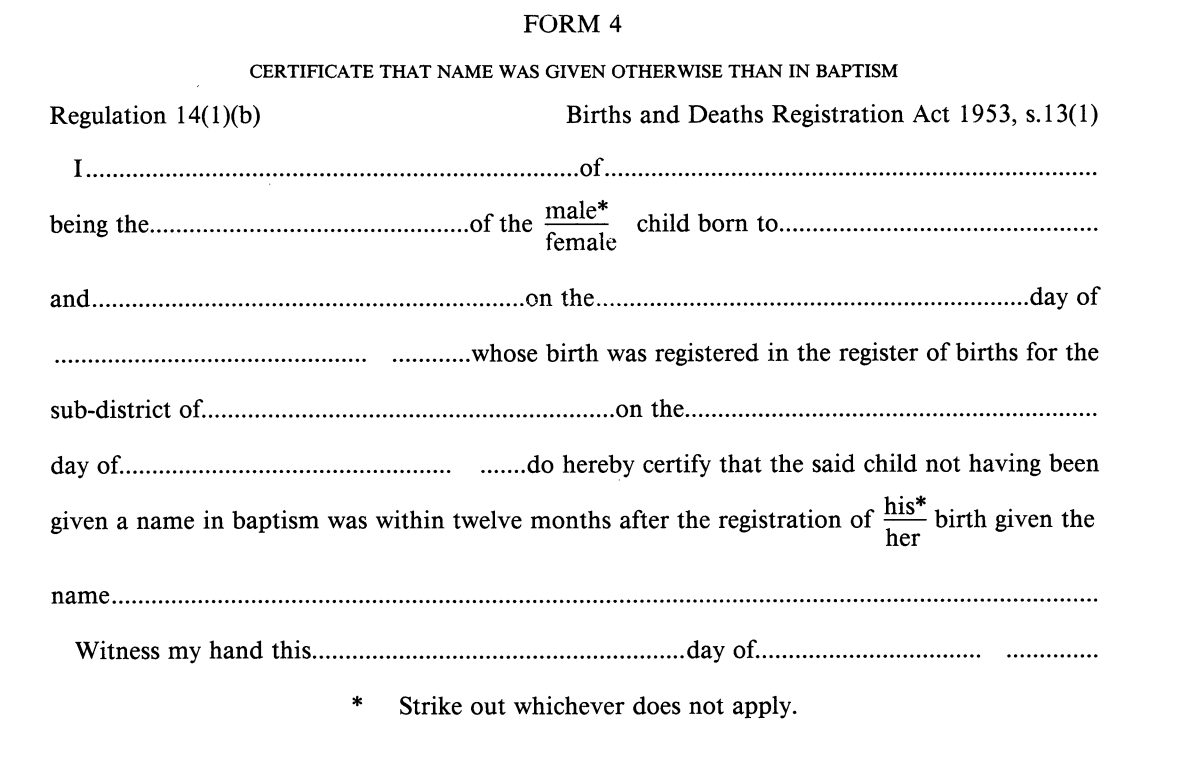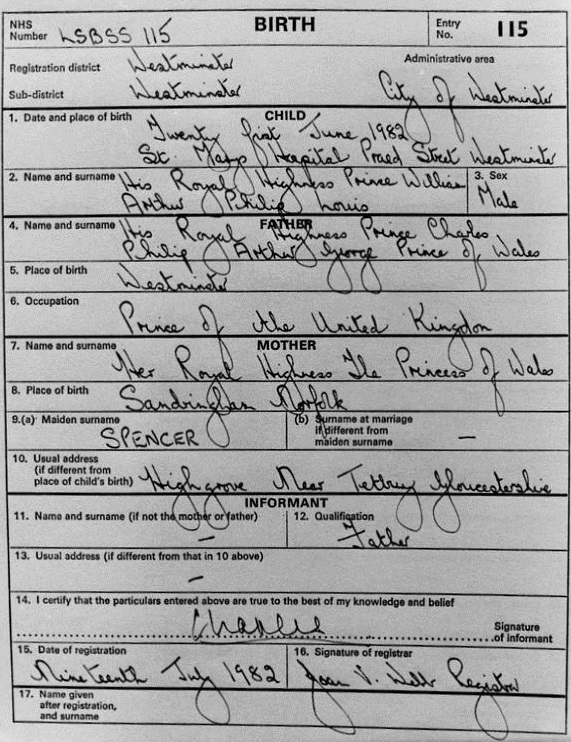Birth registration (England & Wales)
Since 1st July 1837, all births (and stillbirths) in England & Wales have had to be registered with the registrar of births and deaths in the sub-district where the child was born. (See section 1 of the Births and Deaths Registration Act 1953 .)
Originally (in 1837), only the name (i.e. the forenames) of the child were recorded on the registration — and not the surname. It was presumed that the child would have taken their father’s surname (if the parents were married) or the mother’s surname (if they weren’t married).
(Regulation 65(2)(a)(ii) provides that when (now) compiling a short certificate from a historic entry of this sort, the father or mother’s surname should be used (as it was recorded on the entry itself) as the child’s surname. In reality, the child may have adopted a completely different surname, but there is no way of knowing from the birth registration alone.)
From 1st April 1969, both a name and surname were recorded on a child’s birth registration.
The current law

The particulars of the birth which must currently be registered are prescribed by form 1 and regulation 9 of the Registration of Births and Deaths Regulations 1987 .
In form 1 —
- space 2 is for the child’s “name and surname”
- space 17 is for the “name given after registration, and surname”
Regulation 2(1) makes clear that —
In these Regulations, unless the context otherwise requires — …
“name”, in relation to a person, excludes surname; …
Regulation 9(2) provides —
With respect to space 2 (name and surname) —
- (a) if a name is not given, the registrar shall enter only the surname, preceded by a horizontal line;
- (b) the surname to be entered shall be the surname by which at the date of the registration of the birth it is intended that the child shall be known.
The UN Convention on the Rights of the Child
The U.K. is a signatory to the UN Convention on the Rights of the Child , of which article 7, paragraph 1 provides —
The child shall be registered immediately after birth and shall have the right from birth to a name, the right to acquire a nationality and. as far as possible, the right to know and be cared for by his or her parents.
All births are, of course, registered in the U.K. anyway — but to date, no legislation has been enacted which explicitly provides that a child must be given a name.
Adding (or changing) the child’s forenames


The regulations allow for parents to choose their child’s forenames after the 42 days which they’re allowed for the registration of the birth.
This allows parents to baptise their child after the birth registration, and still give the child a name at that point.
The regulations give the same rights to parents to parents who are not Christian, or who choose not to baptise their children.
The forenames (but not the surname) can be changed on the original birth registration, if, within 12 months of the original registration —
- the child was baptised in a different name
- the child hasn’t been baptised, and their name was changed
- the child wasn’t given any name by the time of registration, but was given a name afterwards (by baptism or otherwise)
To re-register the child’s forenames, the mother or father must use form 3 if the name was given in baptism or form 4 if it was given otherwise than in baptism.
For practical information as to how to change your child’s forenames in this way, see our section on changing birth certificates.
How does a child get their name?
The law presumes that a person’s legal name is their name as recorded on their birth certificate.
If a person’s surname is not recorded on their birth certificate (as was the case with older registrations), then the surname is taken to be their father’s surname, or — if the father’s details are not shown on the birth certificate — their mother’s surname.
Before 1st July 1837 (when civil registration began), a person’s name was presumed to be their baptismal name (or “Christian name”). Obviously, though, not everyone is (or was) baptised, or even a Christian — and yet people have always had names.
The courts have held that the name of someone who has not been baptised is the name they are generally called and known by. The same thing applies to the surname of someone who is legally illegitimate (historically, a “bastard”). In fact historically surnames came about in this way anyway, as an extra name that a person came to be known by.
Civil registration has not changed the law in this respect. Registration of a birth does not grant a name (or surname) to a child. Registration is a matter of recording (and of course registering) information about the birth (normally by one or both of the parents). One of the particulars to be registered is of course the child’s name, but it is clear from the regulations that a name may be given to the child either before or after the birth. People, after all, had names (and surnames) before civil registration came about. Registration merely records the name that has been given to the child by the parents.
What name / surname can be given
Parents have can give their child whatever name or surname they want.
Although it’s traditional to give a child the father’s surname, or, less commonly, the mother’s surname, the child’s surname could be a combination of both (for example) — or something completely different. In fact there’s nothing in the regulations (or in the statute) which restricts the parents’ choice of name (or surname), and the registrar doesn’t have the right to refuse a name, except insofar as he might think it were something illegal (e.g. something racist).
Neither is there anything in the regulations which says that the name must be in the Roman script, or even that it must consist of letters (it could consist of numerals, for example). Ultimately, it has to be a truthful record of the name and surname that the parents give to their child.
Whether a name / surname must be entered at all
There is nothing in the statute, or in regulations, which say that a name or surname must be given to a child (although to give a child no name or surname at all would be contrary to the UN Convention on the Rights of the Child). However, if the child has indeed been given a name, or the child is, at the point of registration, intended to be known by a surname, then it must be declared on the birth registration.
Forenames
The regulations explicitly provide for children who have not been given any name (i.e. forenames) by the time of registration. This is because, traditionally, the name would have been given by baptism, and the regulations allow that the baptism may take place (or the child’s name is otherwise given) after the birth registration.

The language of baptism still underlies the regulations; thus the registration records the name that the child is “given” (as it would be in baptism), but it records the surname that “it is intended that the child shall be known” (seeing as baptism is concerned only with the forename(s) of the child, and not the surname).
Surname
It isn’t explicitly clear from the regulations whether a surname must be given to the child or not; however, if the child is intended to be known by any surname, it must of course be declared on the birth registration.
Nevertheless, the General Register Office will accept registrations without a surname being given, for example with the birth of Prince William who was registered as “His Royal Highness Prince William Arthur Philip Louis” (in the same way as other members of the royal family).
How the name / surname are entered
There is a single space on the birth registration for “name and surname” — that is, they are not entered separately — and therefore —
- if the child is given a single name (that is, a name and — like Prince William — no surname) then the name should simply be entered as it is, e.g. “John”
- if the child is given a surname, but no forename, then it should be entered with a horizontal line before it, e.g. “ — Smith”
- if the child is given no name or surname, then just a horizontal line should be entered, i.e. “ — ” (however, the child should be given a name at some point, as they have a right to a name under the UN Convention on the Rights of the Child)
- if the child is a peer of the realm, and will be known by a title or style, then the title / style should also be entered, as it would be considered part of the child’s legal name
The parents’ names
If the parents are married at the time of birth, they each have a duty (and the right) to register their child’s birth. If they are not married, then it is the mother’s duty only, but the parents can register the birth together, and sign the register, if they agree and wish to do so.
The parents (or the mother, if they are not married) must enter their names as at the time of the child’s birth. However, the regulations allow for situations where the parents have changed their name between the time of the birth and the registration — in which case both the old and new names should be recorded, e.g. “John Smith now Fred Smith”.
For the mother, Regulation 9(6) provides —
With respect to space 7 (mother’s name and surname) –
- (a) if after the birth of the child the mother acquired a name or surname different from that borne by her at the date of the birth, the registrar shall enter the name and surname as at the date of the birth, followed by the name and surname as at the date of registration preceded by the word “now” or, if the mother is deceased, the name and surname as at her death preceded by the word “afterwards”
Similarly, for the father, Regulation 9(4) provides —
With respect to space 4 (father’s name and surname) –
- (a) if, other than in a case to which sub-paragraph (b) applies, the father acquired after the child’s birth a name or surname different from that borne by him at the date of the birth, the registrar shall (subject to section 10 of the Act) enter in space 4 the name and surname as at the date of the birth, followed by the name and surname as at the date of registration preceded by the word “now” or, if the father is deceased, the name and surname at his death preceded by the word “afterwards”
To be clear though — the child’s name and surname which should be recorded is that at the time of registration, not at the time of birth (when they may not have a name yet).

